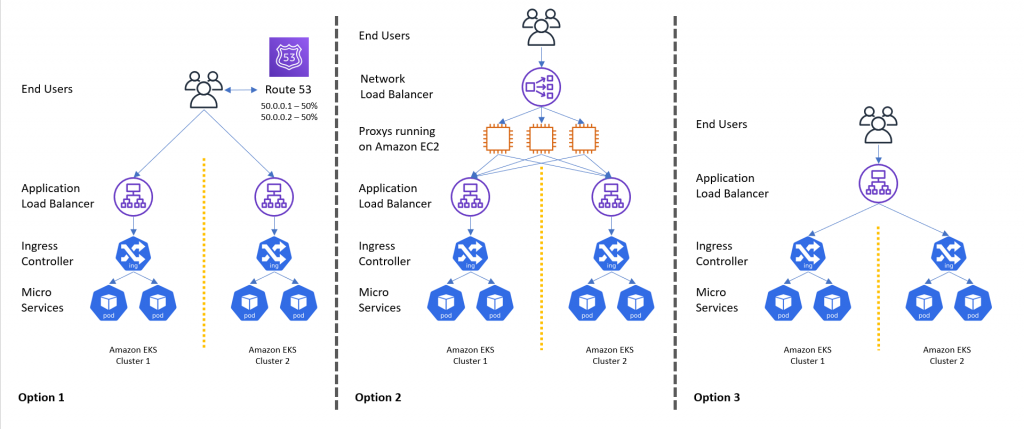Containers
Tag: Kubernetes
Fine-grained IAM roles for Red Hat OpenShift Service on AWS (ROSA) workloads with STS
Red Hat OpenShift Service on AWS (ROSA) is a fully managed OpenShift service, jointly supported by both Red Hat and Amazon Web Services (AWS) and managed by the Red Hat SRE team. This relieves customers of cluster lifecycle management, allowing them to focus on building applications rather than maintaining the OpenShift clusters. ROSA has recently […]
Amazon EKS now supports Kubernetes 1.22
The Amazon Elastic Kubernetes Service (Amazon EKS) team is pleased to announce support for Kubernetes 1.22. Amazon EKS, Amazon EKS Distro, and Amazon EKS Anywhere can now run Kubernetes version 1.22. The upstream project theme for this release is “Reaching New Peaks.” The theme for the release, according to release lead Savitha Raghunathan, is due to what she […]
MYCOM OSI’s Amazon EKS adoption journey
This post was co-written by Dirk Michel, SVP SaaS and Digital Technology at MYCOM OSI, and Andreas Lindh, Specialist Solutions Architect, Containers at AWS. In this blog post, we will discuss how MYCOM OSI was able to lower costs and improve the flexibility of their Assurance Cloud Service (ACS) SaaS platform and bring-your-own-cloud (BYOC) option […]
Protect Kubernetes workloads from Apache Log4j vulnerabilities
Log4j is among the most popular and highly used logging frameworks in Java-based applications. On December 9, 2021, the world became aware of zero-day vulnerabilities CVE-2021-44228 and CVE-2021-45105 affecting the popular Apache package. Any attacker who can control log messages or log message parameters can execute arbitrary code loaded from malicious LDAP servers when message […]
Amazon EKS launches IPv6 support
The ongoing growth of the internet, particularly in the fields of mobile applications, IoT, and application modernization, has led to an industry-wide move to IPv6. With 128 bits of address space, IPv6 can provide 340 undecillion IP addresses, compared to 4.3 billion IPv4 addresses. Over the last several years, Amazon Web Services (AWS) has added […]
Onfido’s Journey to a Multi-Cluster Amazon EKS Architecture
This blog was coauthored by Eugene Malihins, Senior DevOps Engineer at Onfido, and Olly Pomeroy, Containers Specialist SA at Amazon Web Services Who is Onfido? Onfido is setting the new standard for digital access. The company digitally proves a user’s real identity using artificial intelligence (AI) by verifying a photo ID and comparing it to […]
Chaos Engineering with LitmusChaos on Amazon EKS
Introduction Organizations are embracing microservices-based architectures by refactoring large monolith applications into smaller, independent, and loosely coupled services. These independent services are faster to deploy and scale, enabling organizations to innovate and deliver faster. However, as the application grows, these microservices present their own challenges. For example, as you deploy tens or hundreds or thousands […]
Best practices for running Spark on Amazon EKS
Amazon EKS is becoming a popular choice among AWS customers for scheduling Spark applications on Kubernetes. It’s fully managed but still offers full Kubernetes capabilities for consolidating different workloads and getting a flexible scheduling API to optimize resources consumption. But Kubernetes is complex, and not all data engineers are familiar with how to set up […]
Collecting data from edge devices using Kubernetes and AWS IoT Greengrass V2
Kubernetes is open-source software that allows you to deploy and manage containerized applications at scale. It manages clusters of Amazon Elastic Compute Cloud (Amazon EC2) compute instances and runs containers on those instances with processes for deployment, maintenance, and scaling. Using Kubernetes, you can run any type of containerized application using the same toolset on […]
How to use Application Load Balancer and Amazon Cognito to authenticate users for your Kubernetes web apps
This post describes how to use Amazon Cognito to authenticate users for web apps running in an Amazon Elastic Kubernetes Services (Amazon EKS) cluster. Behind any identity management system resides a complex network of systems meant to keep data and services secure. These systems handle functions such as directory services, access management, identity authentication, and […]









